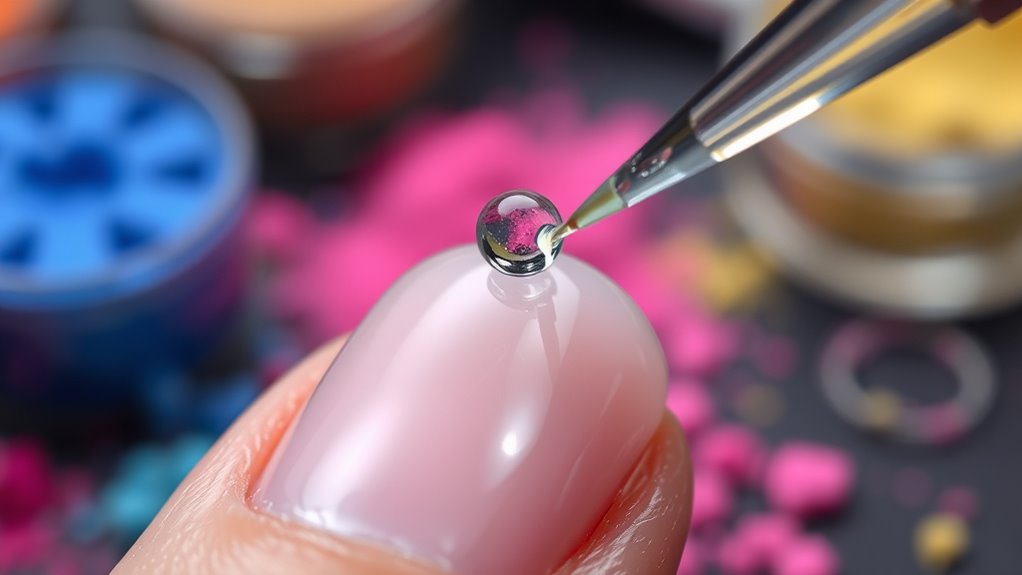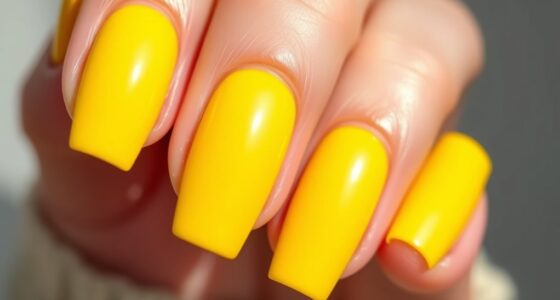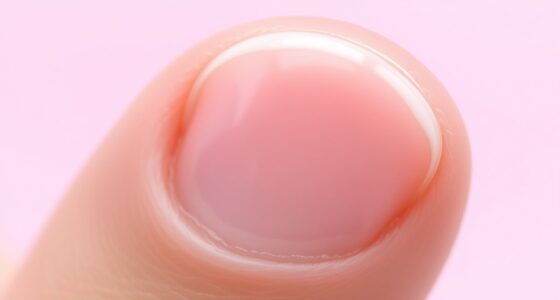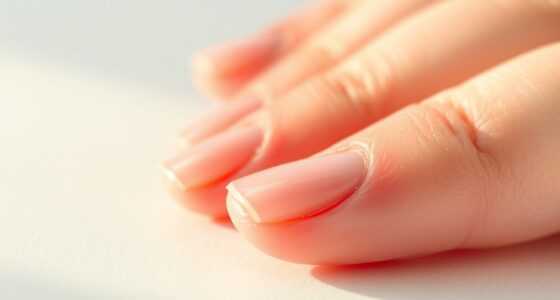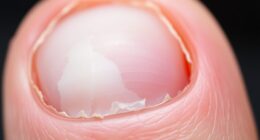Acrylic nails are created by mixing monomers and polymers through a chemical process called polymerization. The monomers are reactive liquids that, when combined with polymers—long chain molecules—form a strong, durable surface. This process involves initiation, where the chains start forming, and crosslinking, which bonds the chains for added strength. Understanding how these chemicals work together helps you appreciate the durability and artistry behind acrylic nails, and you’ll discover more about their fascinating chemistry below.
Key Takeaways
- Monomers are reactive liquid compounds that polymerize with powders to form a solid acrylic nail surface.
- Polymerization involves chemical reactions that link monomers into long chains, creating a durable network.
- Crosslinking bonds between polymer chains enhance strength, flexibility, and resistance to damage.
- Proper handling and curing conditions influence the stability and longevity of acrylic nails.
- UV light and chemical activators accelerate polymer crosslinking, improving durability and finish quality.
Understanding the Basics of Acrylic Nails

Acrylic nails are a popular choice for those looking to enhance the appearance of their natural nails, but understanding how they work begins with the basics. When you explore nail design trends, you’ll see a variety of styles that often rely on acrylics for durability and creativity. Knowing how acrylic nails are applied helps you appreciate the process and guarantees safety. Salon safety protocols are vital; trained technicians follow strict guidelines to prevent infections and ensure proper hygiene. The acrylic mix forms a durable surface, allowing for intricate designs and long-lasting wear. Additionally, understanding leadership skills can help you communicate effectively with your technician and ensure your expectations are met. By understanding these fundamentals, you can make informed choices about your nail enhancements while enjoying the latest trends safely and confidently.
The Role of Monomers in Nail Enhancement

Monomers are key to creating strong, durable acrylic nails because of their unique chemical properties. When you mix monomers with polymers, they undergo a process called polymerization, forming the solid structure that enhances your nails. Understanding how this process works helps you appreciate the science behind long-lasting nail enhancements. Proper handling and application of monomers can also influence overall nail quality and durability.
Monomer’s Chemical Properties
Understanding the chemical properties of monomers is essential because they drive the formation and stability of acrylic nails. The monomer’s reactivity determines how quickly and effectively it bonds with the polymer, impacting the final strength and durability of the enhancement. A highly reactive monomer can polymerize rapidly, but it may also increase the risk of over-curing or uneven application. Conversely, chemical stability guarantees the monomer remains safe to handle and maintains consistent performance during application. Stability also influences shelf life and storage, preventing premature polymerization. By controlling these properties, nail technicians can achieve consistent, reliable results. The balance between reactivity and stability is vital for producing acrylic nails that are both strong and safe for clients. Proper understanding of industry trends allows professionals to select the most suitable monomers for various applications.
Polymer Formation Process
The polymer formation process begins when the monomers react with the polymerizing agent, creating long chains that form the sturdy structure of acrylic nails. During this reaction, cross linking occurs through cross linking reactions, where bonds form between polymer chains, increasing strength and durability. These reactions are essential for giving acrylic nails their rigidity and resilience. The curing mechanisms initiate the polymerization, often triggered by air exposure or chemical activators, which kick-start the chain-growth process. As the monomers link together, they form a cohesive, solid network that adheres to the natural nail. An understanding of grocery store hours can assist in planning shopping trips to ensure product availability and convenience. This process guarantees the nails are both durable and flexible, providing a natural appearance while maintaining strength. Understanding these mechanisms helps explain how acrylic nails achieve their iconic durability and finish.
How Polymers Contribute to Durability and Shape

Polymers form strong networks that give acrylic nails their durability, helping them resist chipping and breaking. They also provide flexibility, so your nails can bend without cracking. Plus, their shape retention properties guarantee your nails stay well-formed and last longer.
Strength Through Polymer Networks
Polymer networks are key to guaranteeing acrylic nails are both durable and maintain their shape. These networks form through polymer crosslinking, creating a robust structure that withstands daily wear. When the monomer stays stable during polymerization, it helps solidify the network, preventing cracks and deformations. The interconnected polymer chains distribute stress evenly, enhancing strength. To maximize durability, focus on:
- Proper polymer crosslinking to reinforce the network
- Maintaining monomer stability during curing
- Ensuring even distribution of polymer chains for consistent strength
- Polymerization process plays a crucial role in achieving a strong, resilient structure.
This interconnected structure ensures your acrylic nails resist chipping and bending, providing long-lasting beauty. By understanding how polymer networks work, you can appreciate the science behind their resilience and shape retention, keeping your nails looking flawless for weeks.
Flexibility and Resilience
Building on the strength provided by polymer networks, their inherent flexibility and resilience allow acrylic nails to absorb impacts and adapt to movement without cracking or breaking. The flexibility benefits enable your nails to bend slightly under pressure, reducing the risk of fractures. Resilience factors help the acrylic surface recover from minor stresses, maintaining durability over time. This combination ensures your nails can handle everyday activities and accidental bumps without losing their shape. The polymer’s flexible nature distributes stress evenly, preventing weak points. As a result, your acrylic nails remain durable, resilient, and comfortable, giving you confidence in their ability to withstand routine wear. This resilience and flexibility are essential for achieving long-lasting, natural-looking nails that move with you.
Shape Retention Properties
Because of their flexible molecular structure, polymers in acrylic nails play a crucial role in maintaining their shape over time. Their durability depends on adhesion principles that guarantee a strong bond with your natural nail, preventing lifting or cracking. Polymers also contribute to color stability, keeping your nails looking vibrant longer. They resist everyday impacts, helping the shape stay intact even with regular activity. Key factors include:
- Strong polymer networks that support shape retention and resist deformation
- Enhanced adhesion to natural nails, reducing the risk of separation
- Stability against pigments, preserving color vibrancy over time
- Proper application techniques enhance the effectiveness of polymers in maintaining shape and durability.
Together, these properties ensure your acrylic nails retain their original shape and appearance, providing lasting beauty and durability.
The Polymerization Process: Creating Strong Nail Extensions

The polymerization process is essential for creating durable and strong nail extensions. When the monomer and polymer mix, they undergo polymerization, forming a solid, interconnected structure. UV curing accelerates this process, causing rapid polymer crosslinking that strengthens the nail. As the polymer chains link, your nails become more resistant to chips and cracks. Proper curing guarantees the maximum bond and durability. Additionally, understanding the polymerization process helps in optimizing nail strength and longevity.
| Step | Result |
|---|---|
| UV exposure | Fast, complete polymer crosslinking |
| Polymer crosslinking | Creates a resilient, cohesive nail structure |
| Curing time | Ensures ideal strength |
| Final product | Strong, durable nail extension |
Factors Influencing the Chemistry of Acrylic Nails

Several factors influence the chemistry of acrylic nails, affecting their durability, appearance, and application process. Your choice of monomer and polymer, as well as environmental conditions, play a key role in chemical stability. For example, high temperatures or humidity can alter the curing process, impacting how well the acrylic sets. Additionally, the ingredients’ chemical stability determines how long the nails last without cracking or lifting. Environmental impact also matters; using eco-friendly products can reduce harmful emissions and waste. Consider these factors:
- Temperature and humidity during application
- Quality and formulation of monomer and polymer
- Use of environmentally safe materials
- Proper storage of acrylic components ensures their effectiveness and longevity.
The Artistry Behind the Chemistry: Customizing Your Manicure
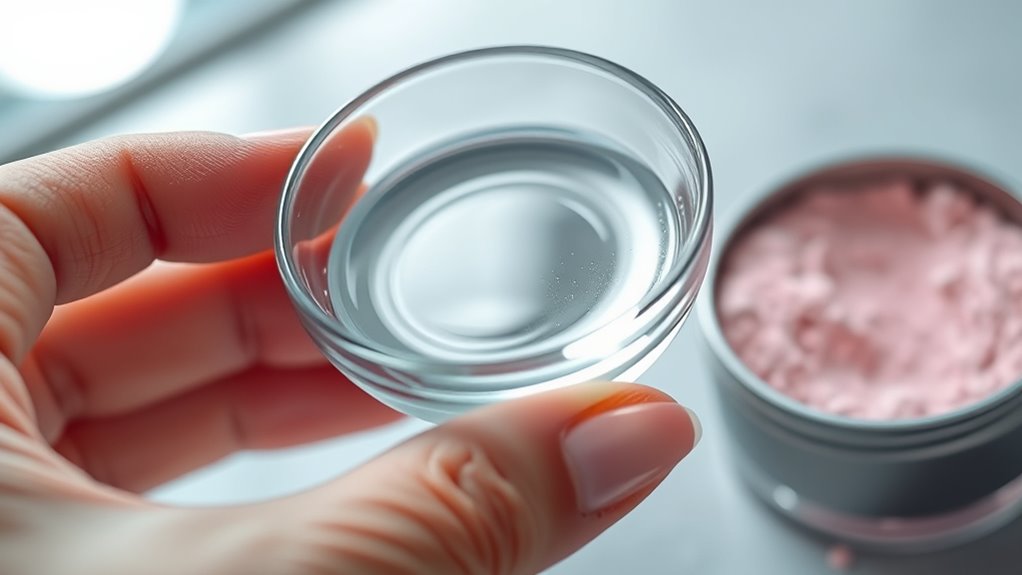
While the chemistry of acrylic nails provides a strong foundation, true artistry comes from customizing each manicure to reflect your personal style. You can experiment with various nail art techniques, such as intricate designs, 3D embellishments, or seasonal themes, to make your nails uniquely yours. Ensuring polish compatibility is essential; some polishes work better over acrylics, allowing for smooth application and long-lasting results. Before applying your chosen designs, consider the texture and finish of your acrylics to prevent chipping or peeling. With the right combination of nail art techniques and compatible polishes, you can elevate your acrylic manicure from simple to stunning, showcasing your creativity while maintaining the durability and strength provided by the chemistry behind acrylic nails. Additionally, understanding WWE Raw’s Financial Impact can inspire you to invest in quality materials that enhance your nail art’s longevity and overall look.
Frequently Asked Questions
How Long Does the Acrylic Nail Process Typically Take?
The acrylic nail process usually takes about 1 to 2 hours, depending on your nail technician’s experience and the design you want. The application duration involves prepping, applying the acrylic mixture, shaping, and curing, which all contribute to the appointment length. If you’re getting a simple set, it might be quicker, but intricate designs or repairs could extend the appointment. Make sure to schedule enough time for a thorough and relaxed experience.
Are There Any Health Risks Associated With Acrylic Nail Chemicals?
Are you aware of the health concerns linked to acrylic nail chemicals? Yes, prolonged chemical exposure can cause skin irritation, allergic reactions, or respiratory issues. While occasional use is generally safe, frequent salon visits increase risks. To protect yourself, guarantee proper ventilation and choose reputable salons. Are you willing to take these precautions? Staying informed helps you enjoy beautiful nails without compromising your health.
Can Acrylic Nails Be Safely Removed at Home?
You can remove acrylic nails at home with DIY removal, but it’s important to prioritize safety precautions. Soak your nails in acetone for about 15-20 minutes, then gently lift the acrylic with a cuticle pusher. Avoid force or ripping to prevent damage. Always work in a well-ventilated area, wear gloves, and follow instructions carefully. If unsure, consider visiting a professional to avoid potential harm.
How Do Different Monomer and Polymer Combinations Affect Nail Finish?
The variety of monomer ratios and polymer types can dramatically transform your nail finish—it’s like customizing a masterpiece. Higher monomer ratios create a softer, more flexible look, while lower ratios result in a stronger, more durable surface. Different polymer types, such as polymethyl methacrylate (PMMA) or other acrylics, influence shine and texture. You can achieve anything from a glossy, natural glow to a bold, matte finish by mixing these combinations wisely.
What Innovations Are Emerging in Acrylic Nail Chemistry?
You’ll see exciting innovations in acrylic nail chemistry like nanotechnology, which enhances durability and precision, and eco-friendly formulations that reduce environmental impact. These advancements let you enjoy longer-lasting nails with healthier ingredients, minimizing chemical exposure. Manufacturers are increasingly focusing on sustainable materials and smarter delivery systems, making your nail care safer and more environmentally conscious. Keep an eye out for these cutting-edge developments that transform your nail experience.
Conclusion
Now you see, acrylic nails are like a carefully crafted symphony, where monomers and polymers play their parts perfectly. Understanding their chemistry helps you appreciate the magic behind those stunning, durable nails. When you choose your styles, you’re not just picking a look – you’re embracing a science that holds everything together. So, next time you admire your nails, remember the tiny chemistry heroes working behind the scenes to keep them beautiful.
